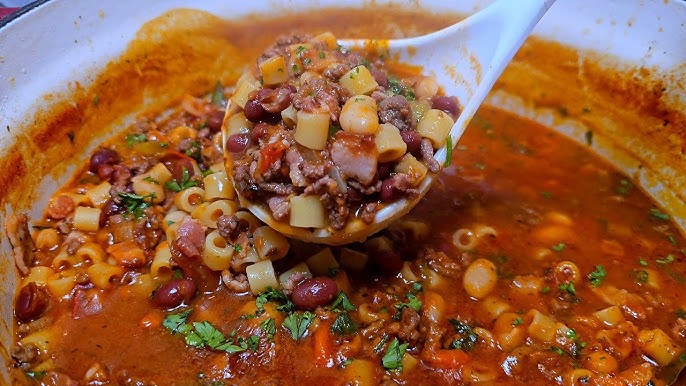Pasta Fagioli Recipe: Pasta Fagioli, often called “Pasta Fazool” in Italian-American communities, is a hearty and comforting soup made with pasta and beans. This classic Italian dish translates directly to “pasta and beans,” highlighting its simple yet satisfying essence. Traditionally considered a peasant food, its versatility has made it a beloved recipe worldwide.
Origins of this Comfort Food Classic
The roots of Pasta Fagioli lie in Italy’s cucina povera—“cooking of the poor.” It originated as a humble, nourishing meal crafted from pantry staples, such as beans and pasta. Over time, regional variations have brought unique twists, from the inclusion of meat in the north to the vegetarian versions found in southern Italy.
Ingredients Needed for Pasta Fagioli
Main Ingredients
Here’s what you’ll need to create a classic Pasta Fagioli:
- Pasta: Small types like ditalini or elbow macaroni.
- Beans: Cannellini or borlotti beans, soaked or canned.
- Vegetables: Onion, garlic, carrots, and celery.
- Tomato Base: Crushed tomatoes or tomato paste.
- Broth: Chicken, vegetable, or water for the base.
- Herbs: Rosemary, thyme, parsley, and bay leaves.
- Olive Oil: For sautéing the aromatics.
Optional Additions for Flavor
- Pancetta or bacon for a smoky depth.
- Parmesan rind for richness during simmering.
- Red pepper flakes for a spicy kick.
Tips for Selecting the Best Ingredients
Freshness matters! Use high-quality olive oil, fresh herbs, and good canned tomatoes for the best results. If possible, opt for dried beans for a deeper flavor, but canned beans are a convenient and time-saving alternative.
Tools and Equipment
Kitchen Essentials for Pasta Fagioli
- Large pot or Dutch oven for simmering the soup.
- Wooden spoon for stirring without scratching.
- Chef’s knife and cutting board for chopping vegetables.
- Ladle for serving.
Alternatives for Missing Tools
No Dutch oven? A stockpot will work just fine. If you don’t have a ladle, use a sturdy spoon to dish out portions.
Preparing for the Recipe
Prepping the Ingredients
- Rinse the beans thoroughly if using canned.
- Dice onions, carrots, and celery into uniform sizes for even cooking.
- Mince garlic finely for maximum flavor release.
- Measure out herbs and spices beforehand to save time.
Organizing Your Workspace
Keep all ingredients within arm’s reach. A clean and organized kitchen ensures a smooth cooking process and allows you to focus on perfecting your Pasta Fagioli.
Step-by-Step Instructions
Cooking the Aromatics
- Heat a generous drizzle of olive oil in a large pot over medium heat.
- Add onions, carrots, and celery; sauté until softened (5–7 minutes).
- Stir in minced garlic, allowing it to release its aroma for about 1 minute.
Adding the Beans and Broth
- Add the beans, crushed tomatoes, and a Parmesan rind (if using).
- Pour in the broth, stirring to combine.
- Season with salt, pepper, and your chosen herbs.
Cooking the Pasta
- Bring the mixture to a gentle boil, then reduce to a simmer.
- Add the pasta directly to the soup, cooking until al dente (check the package instructions). Stir occasionally to prevent sticking.
Combining and Simmering
- Once the pasta is cooked, adjust the soup’s thickness. Add water or broth if it’s too thick or simmer longer to reduce excess liquid.
- Taste and adjust seasoning as needed. Remove any herb stems or Parmesan rind before serving.
Serving Pasta Fagioli
Best Ways to Serve
Pasta Fagioli is best served piping hot, straight from the pot. Ladle it into bowls, ensuring a hearty mix of pasta, beans, and broth in every serving. Traditionally, it’s paired with crusty bread for dipping, which soaks up the delicious flavors beautifully.
Recommended Garnishes
- A drizzle of high-quality extra virgin olive oil for a fresh finish.
- Freshly grated Parmesan or Pecorino Romano cheese for added richness.
- A sprinkle of chopped parsley to brighten the dish.
- For a hint of spice, add a dash of red pepper flakes.
Tips for Storing and Reheating
Storing in the Refrigerator
Allow the soup to cool to room temperature before transferring it to an airtight container. Store in the refrigerator for up to 3–4 days. If the pasta absorbs too much broth, simply add a splash of water or stock when reheating.
Freezing for Later
Pasta Fagioli freezes well, but for best results, cook the pasta separately and add it only when reheating. Store the soup base in a freezer-safe container for up to 3 months.
Reheating Without Losing Flavor
Reheat gently on the stovetop over low heat, stirring occasionally. Add additional broth or water to restore the desired consistency. Avoid using high heat, which can overcook the pasta.
Variations of Pasta Fagioli
Vegetarian Pasta Fagioli
For a vegetarian twist, use vegetable broth and skip the pancetta or bacon. Add more veggies like zucchini or spinach for a nutrient boost.
Meaty Pasta Fagioli
Enhance the flavor with pancetta, Italian sausage, or ground beef. Brown the meat first before sautéing the vegetables, allowing the drippings to enrich the base.
Gluten-Free Alternatives
Replace traditional pasta with gluten-free options, such as chickpea or rice pasta. Ensure your broth is also certified gluten-free for a safe and delicious meal.
Nutritional Benefits of Pasta Fagioli
Protein-Packed Beans
Beans are a powerhouse of plant-based protein and fiber, making Pasta Fagioli a satisfying and nourishing dish. They’re also rich in vitamins and minerals, including iron and potassium.
Low-Cost, High-Nutrition
This recipe is budget-friendly, relying on pantry staples that are both affordable and nutritious. It’s a great option for families or anyone looking to eat well on a budget.
Adapting for Specific Diets
Pasta Fagioli can be tailored to fit various dietary needs. Use low-sodium broth for a heart-healthy version, or substitute with dairy-free Parmesan for a vegan-friendly dish.
Common Mistakes to Avoid
Overcooking the Pasta
Adding the pasta too early can lead to a mushy texture. Always cook the pasta to al dente and add it toward the end of the simmering process.
Skipping the Aromatics
Don’t skip the onion, garlic, celery, and carrot base. These ingredients build the soup’s foundational flavors and are essential to its authentic taste.
Not Adjusting for Personal Taste
Pasta Fagioli is highly customizable. Taste the soup throughout the cooking process and adjust the seasoning to match your preferences. Remember, a pinch of salt or a splash of vinegar can make all the difference.
FAQs About Pasta Fagioli Recipe
1. What is Pasta Fagioli?
Pasta Fagioli, also known as “Pasta e Fagioli,” is a traditional Italian soup made with pasta, beans, and a flavorful tomato-based broth. It’s a hearty and comforting dish perfect for any season.
2. What kind of beans are used in Pasta Fagioli?
Cannellini beans or great northern beans are typically used, but you can substitute with kidney beans or navy beans based on your preference.
3. What type of pasta works best for this recipe?
Small pasta shapes like ditalini, elbow macaroni, or small shells are ideal as they blend seamlessly with the soup’s texture.
4. Can I make Pasta Fagioli vegetarian?
Yes! Replace chicken broth with vegetable broth and skip any meat additions like pancetta for a delicious vegetarian version.
5. How can I store leftovers?
Allow the soup to cool completely, then store it in an airtight container in the refrigerator for up to 3 days. For longer storage, freeze it for up to 3 months.
6. How do I prevent the pasta from getting mushy?
Cook the pasta separately and add it to the soup just before serving. Alternatively, undercook the pasta slightly if cooking directly in the soup.
7. Can I customize the recipe?
Absolutely! Add vegetables like carrots, celery, or spinach for extra nutrients, or adjust the seasonings to your taste.
Conclusion
Pasta Fagioli is the ultimate comfort food—simple, hearty, and packed with flavor. Whether you enjoy it as a standalone meal or a starter, it’s a dish that brings warmth and joy to any table. By following this step-by-step guide, you’ll have a recipe that’s sure to impress family and friends alike. Buon appetito!



